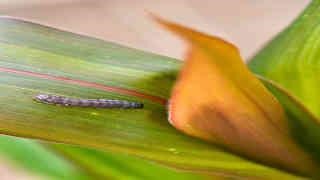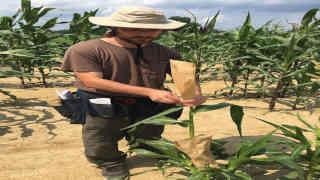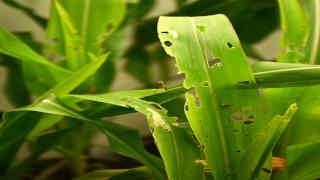Plant flavonoids are natural compounds that often are seen as pigments in some flowers, vegetables and fruits. Flavonoids normally are considered nonessential byproducts of a plant’s primary metabolism, which produces sugars and other metabolites that work together to produce seed yield.
“When you survey the leaves and other parts of commercially grown corn, you do not see production of these flavonoids anymore,” he said. “These compounds were naturally present at one point until we started breeding against them. Actually, we did not breed against them so much as we just lost them trying to develop higher-yielding varieties.”

Debamalya Chatterjee, co-lead author of the research, with hybrid corn line.
For two decades, Chopra’s research group in the College of Agricultural Sciences has studied mutant lines of corn that overproduce the flavonoids and has developed new lines that combine flavonoid overproduction with other desirable traits. And his lab has taken the gene that produces a precursor compound of flavonoids in sorghum and inserted this gene into corn to make more resilient plants that can discourage feeding by fall armyworms and possibly other pests.
Fall armyworm caterpillars are so destructive because they often feed on the younger corn leaves inside the whorl where they grow, Chopra explained. They stay inside the whorl gorging, and when the whorl opens, the young leaves already are destroyed.

A fall armyworm caterpillar near the whorl of a corn plant.
In the study, the researchers demonstrated in a three-part experiment that sorghum and corn flavonoids affect survival of fall armyworm larvae. Their findings, recently published in the Journal of Pest Science, revealed that fall armyworm larvae reared in the lab on an artificial diet supplemented with sorghum flavonoids showed significant mortality and decreased larvae body weight.
To compare the levels of fall armyworm survival and feeding damage, the researchers developed breeding lines and grew four related lines of corn at Penn State’s Russell E. Larson Agricultural Research Center — two genetically modified lines to produce flavonoids, and two not producing flavonoids.

Co-lead author of the research Tyler Lesko hand-pollinates hybrid corn in the study.
“The feeding assays showed significantly high mortality of larvae that were fed on flavonoid-producer lines compared to nonflavonoid lines or the wild types,” Chopra said. “And significantly less damage was done to corn plants producing flavonoids than to flavonoid-free corn.”
The researchers also extracted leaf flavonoids from certain sorghum lines and sprayed them on leaves of susceptible corn lines. The flavonoid extract effectively reduced the growth and increased the mortality of fall armyworm larvae, making the susceptible lines resistant to fall armyworm larval feeding.
Penn State entomologist Gary Felton, who has been collaborating on this research with Chopra, noted that when fall armyworms ingest flavonoids, their intestinal tract is degraded.

Fall armyworm has spread across more than 100 countries worldwide, presenting unprecedented challenges for farmers. By causing damage much worse than this, the pest has proved especially devastating in the developing world, with the potential to jeopardize the livelihoods and food security of millions.
“The membrane that protects the caterpillar’s gut was severely damaged in larvae fed on leaves of flavonoid-producer corn lines, compared to wild types,” he said. “The effectiveness of the flavonoids as feeding deterrents demonstrates the eco-friendly potential for the management of fall armyworm larvae.”
The U.S. Department of Agriculture’s National Institute of Food and Agriculture supported this work.
Also contributing to this research at Penn State were Debamalya Chatterjee and Tyler Lesko, doctoral degree candidates in the Department of Plant Science; Michelle Peiffer, research support assistant, Department of Entomology; and Dinakaran Elango, a previous graduate student of Chopra’s and now at the Department of Agronomy, Iowa State University. Julien Beuzelin, of the Everglades Research and Education Center, University of Florida, also was a member of the research team.